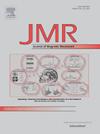Improve robustness to mismatched sampling rate: An alternating deep low-rank approach for exponential function reconstruction and its biomedical magnetic resonance applications
IF 1.9
3区 化学
Q3 BIOCHEMICAL RESEARCH METHODS
引用次数: 0
Abstract
Undersampling accelerates signal acquisition at the expense of introducing artifacts. Removing these artifacts is a fundamental problem in signal processing and this task is also called signal reconstruction. Through modeling signals as the superimposed exponential functions, deep learning has achieved fast and high-fidelity signal reconstruction by training a mapping from the undersampled exponentials to the fully sampled ones. However, the mismatch, such as undersampling rates (25 % vs. 50 %), anatomical region (knee vs. brain), and contrast configurations (PDw vs. T2w), between the training and target data will heavily compromise the reconstruction. To overcome this limitation, we propose Alternating Deep Low-Rank (ADLR), which combines deep learning solvers and classic optimization solvers. Experimental validation on the reconstruction of synthetic and real-world biomedical magnetic resonance signals demonstrates that ADLR can effectively alleviate the mismatch issue and achieve lower reconstruction errors than state-of-the-art methods.

提高对错配采样率的鲁棒性:指数函数重建的交替深度低秩方法及其生物医学磁共振应用
欠采样以引入伪影为代价加速信号采集。去除这些伪影是信号处理中的一个基本问题,这项任务也被称为信号重建。通过将信号建模为叠加的指数函数,深度学习通过训练从欠采样指数到全采样指数的映射,实现了快速高保真的信号重建。然而,训练数据和目标数据之间的不匹配,如采样不足率(25% vs 50%)、解剖区域(膝盖vs大脑)和对比配置(PDw vs T2w),将严重影响重建。为了克服这一限制,我们提出了交替深度低秩(ADLR),它结合了深度学习求解器和经典优化求解器。对合成和真实生物医学磁共振信号的重建实验验证表明,ADLR可以有效地缓解不匹配问题,实现比现有方法更低的重建误差。
本文章由计算机程序翻译,如有差异,请以英文原文为准。
求助全文
约1分钟内获得全文
求助全文
来源期刊
CiteScore
3.80
自引率
13.60%
发文量
150
审稿时长
69 days
期刊介绍:
The Journal of Magnetic Resonance presents original technical and scientific papers in all aspects of magnetic resonance, including nuclear magnetic resonance spectroscopy (NMR) of solids and liquids, electron spin/paramagnetic resonance (EPR), in vivo magnetic resonance imaging (MRI) and spectroscopy (MRS), nuclear quadrupole resonance (NQR) and magnetic resonance phenomena at nearly zero fields or in combination with optics. The Journal''s main aims include deepening the physical principles underlying all these spectroscopies, publishing significant theoretical and experimental results leading to spectral and spatial progress in these areas, and opening new MR-based applications in chemistry, biology and medicine. The Journal also seeks descriptions of novel apparatuses, new experimental protocols, and new procedures of data analysis and interpretation - including computational and quantum-mechanical methods - capable of advancing MR spectroscopy and imaging.

 求助内容:
求助内容: 应助结果提醒方式:
应助结果提醒方式:


